Norwich
Cattle Market street
Chapel Field road
44 Bethel street
Rosary road
Chapel Field road
44 Bethel street
Rosary road
Cattle
Market street area
Imperial Yeomanry Norfolk (King’s Own) head quarters, 21 Tombland (Kelly 1904)
'Norfolk (King's Own Royal Regiment) Yeomanry; head quarters, Cattle Market st.'
'6th (Cyclist) Battalion Norfolk Regiment; head quarters [plus A & H Cos.], Cattle Market street.'
‘The 6th Territorial (Cyclists) Battalion Norfolk Regiment have head quarters at Cattle Market street, jointly with the Norfolk (The King’s Own Royal Regiment) Yeomanry.’
‘Norwich is the head quarters of the Norfolk (The King’s Own Royal Regiment) Yeomanry, and of the A Squadron of the Regiment.’
‘Norwich is also the head quarters [at the Old Militia barracks, Surrey street] of the 1st East Anglian Brigade, and the 2nd and 3rd Norfolk Batteries and 1st East Anglian Ammunition Column, Royal Field Artillery.’
1st East Anglian Brigade, Royal Field Artillery; Head quarters [and 2nd, 3rd Norfolk Batteries plus 1st East Anglian Ammunition Column], Old Militia barracks, All Saints' green.'
Other addresses
'2nd East Anglian Field Ambulance Royal Army Medical Corps. Head quarters [plus A, B & C Sections], Bethel street.' (Address is number 44)
‘The 4th Volunteer Battalion Norfolk Regiment have head quarters at [York house,] 137 Rosary road.’ (Kelly, 1904)
Unless otherwise credited, all unit locations listed above are from Kelly, 1912.
‘The Volunteer Drill Hall in Chapel Field road was opened in [October] 1866 by His late Majesty King Edward VII and Queen Alexandra, the Prince and Princess of Wales, and is a large building of flint and red brick, in the Castellated Gothic style, 144 feet long and 62 feet wide; the tower, which forms part of the old city wall, is now used as an officers’ room. The hall is the head quarters [plus A, B & C Cos.] of the 4th Territorial Battalion Norfolk Regiment.’ (Kelly, 1912)
The architect was the City Surveyor, James Benest and the was builder William Gilbert. As Kelly notes, the Drill Hall incorporated a fragment of one of the semicircular towers, demolished 1963. The site of the tower is now marked by a semicircle of cobbles in the Chapel Field Road roundabout.
Among other events, the Drill Hall was used for concerts. For example, on 17th September, 1912, a promenade concert was held for the Norwich Flood Distress Fund.
Imperial Yeomanry Norfolk (King’s Own) head quarters, 21 Tombland (Kelly 1904)
'Norfolk (King's Own Royal Regiment) Yeomanry; head quarters, Cattle Market st.'
'6th (Cyclist) Battalion Norfolk Regiment; head quarters [plus A & H Cos.], Cattle Market street.'
‘The 6th Territorial (Cyclists) Battalion Norfolk Regiment have head quarters at Cattle Market street, jointly with the Norfolk (The King’s Own Royal Regiment) Yeomanry.’
‘Norwich is the head quarters of the Norfolk (The King’s Own Royal Regiment) Yeomanry, and of the A Squadron of the Regiment.’
All Saints Green area
1st Norfolk Royal Garrison Artillery (Volunteers) Old Militia Barracks, All Saints’ green, Norwich 2,3,4 Heavy Battery All Saints' Green west side between Surrey street and Queen's road (Kelly, 1904)‘Norwich is also the head quarters [at the Old Militia barracks, Surrey street] of the 1st East Anglian Brigade, and the 2nd and 3rd Norfolk Batteries and 1st East Anglian Ammunition Column, Royal Field Artillery.’
1st East Anglian Brigade, Royal Field Artillery; Head quarters [and 2nd, 3rd Norfolk Batteries plus 1st East Anglian Ammunition Column], Old Militia barracks, All Saints' green.'
Other addresses
'2nd East Anglian Field Ambulance Royal Army Medical Corps. Head quarters [plus A, B & C Sections], Bethel street.' (Address is number 44)
‘The 4th Volunteer Battalion Norfolk Regiment have head quarters at [York house,] 137 Rosary road.’ (Kelly, 1904)
Unless otherwise credited, all unit locations listed above are from Kelly, 1912.
Chapel Field road
Kelly, 1904, noted that 1st Volunteer Battalion were based on Chapel Field road between Chapel Field north and Chapel Field gardens.‘The Volunteer Drill Hall in Chapel Field road was opened in [October] 1866 by His late Majesty King Edward VII and Queen Alexandra, the Prince and Princess of Wales, and is a large building of flint and red brick, in the Castellated Gothic style, 144 feet long and 62 feet wide; the tower, which forms part of the old city wall, is now used as an officers’ room. The hall is the head quarters [plus A, B & C Cos.] of the 4th Territorial Battalion Norfolk Regiment.’ (Kelly, 1912)
The architect was the City Surveyor, James Benest and the was builder William Gilbert. As Kelly notes, the Drill Hall incorporated a fragment of one of the semicircular towers, demolished 1963. The site of the tower is now marked by a semicircle of cobbles in the Chapel Field Road roundabout.
Among other events, the Drill Hall was used for concerts. For example, on 17th September, 1912, a promenade concert was held for the Norwich Flood Distress Fund.
Cattle Market street
The Drill Hall is used by an architect practice.
Cattle Market Street
Photograph: Chris Basey
Photograph: Chris Basey
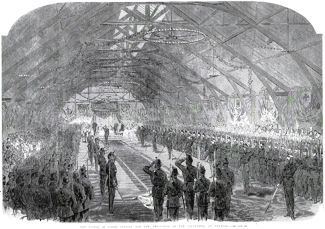
The Prince of Wales opening the new Drill-shed of the Volunteers at Norwich’, from the Illustrated London News, November 10th, 1866. Enlarge
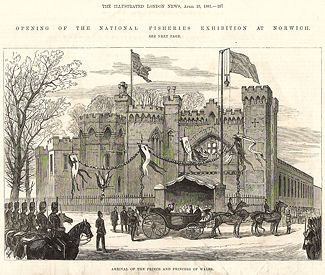
Chapel Field road drill hall.
Enlarged image and accompanying article
Enlarged image and accompanying article
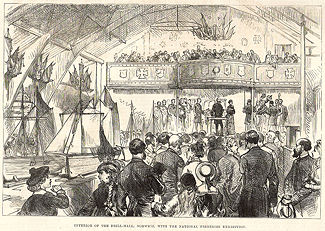
Chapel Field road drill hall.
Enlarged image and accompanying article
Enlarged image and accompanying article
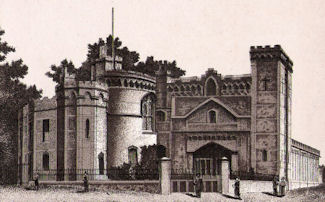
Postcard of Chapel Field road drill hall: Date unknown
Enlarged image
Enlarged image
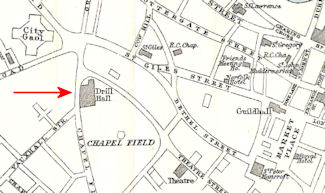
Excerpt from 1892 map showing Chapel Field Drill Hall
Larger excerpt
Larger excerpt
© All material is copyright - refer to the
Terms of Use
the first attempt at content
Introduction
About
Anatomy
Drill
 Database
Database
 Memorabilia
Memorabilia
Resources Glossary
Saving Halls Participate Contact What's New? Terms of Use
Drill
 Database
Database Memorabilia
MemorabiliaResources Glossary
Saving Halls Participate Contact What's New? Terms of Use
The Drill Hall Project - Charting a neglected legacy